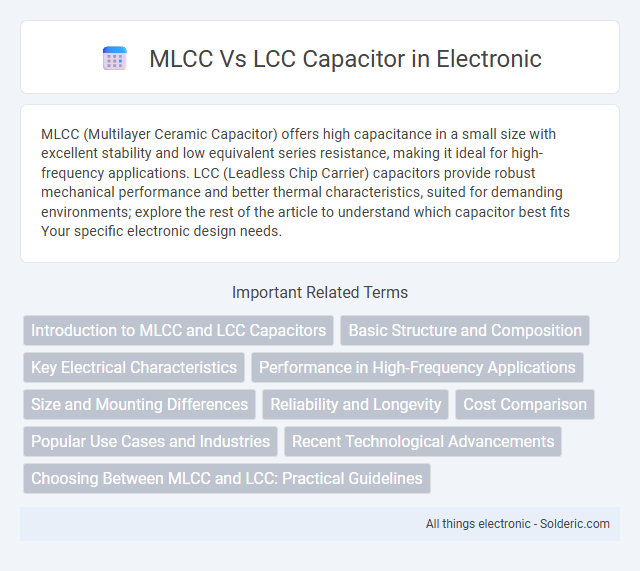MLCC (Multilayer Ceramic Capacitor) offers high capacitance in a small size with excellent stability and low equivalent series resistance, making it ideal for high-frequency applications. LCC (Leadless Chip Carrier) capacitors provide robust mechanical performance and better thermal characteristics, suited for demanding environments; explore the rest of the article to understand which capacitor best fits Your specific electronic design needs.
Comparison Table
| Feature | MLCC Capacitor | LCC Capacitor |
|---|---|---|
| Type | Multilayer Ceramic Capacitor | Layered Ceramic Capacitor |
| Dielectric Material | Ceramic (Class 1 or Class 2) | Ceramic with laminated structure |
| Capacitance Range | 1pF to 100uF | Higher capacitance, typically >10uF |
| Size | Small, chip-style | Larger, laminated layers |
| Voltage Rating | Up to 100V typical | Higher voltage ratings available |
| ESR (Equivalent Series Resistance) | Low ESR | Moderate ESR |
| Applications | High frequency, decoupling, timing circuits | Power electronics, bulk energy storage |
| Temperature Stability | Good (Class 1), Moderate (Class 2) | Enhanced thermal stability |
Introduction to MLCC and LCC Capacitors
MLCC (Multilayer Ceramic Capacitors) consist of multiple ceramic dielectric layers interleaved with metal electrodes, offering high capacitance in a compact size and excellent frequency characteristics. LCC (Leadless Chip Capacitors) are surface-mount capacitors with no leads, often using ceramic or other dielectric materials, designed for improved reliability and ease of assembly in automated manufacturing. Your choice between MLCC and LCC capacitors depends on factors like capacitance value, size constraints, and application-specific performance requirements.
Basic Structure and Composition
MLCC capacitors consist of multiple alternating layers of ceramic dielectric and metal electrodes, creating a compact multilayer structure that enhances capacitance. LCC capacitors feature a larger structure with layers of laminated film and foil electrodes, offering flexibility and higher voltage handling. The ceramic material in MLCCs provides high permittivity, while LCCs use laminated plastic films for stability and low losses.
Key Electrical Characteristics
MLCC capacitors exhibit low Equivalent Series Resistance (ESR) and excellent high-frequency performance, making them ideal for decoupling and filtering applications. LCC capacitors offer higher capacitance values and superior voltage handling with stable dielectric properties under varying temperatures, suited for power supply smoothing. Both types differ significantly in dielectric materials and construction, influencing their capacitance stability, voltage ratings, and overall efficiency in circuit designs.
Performance in High-Frequency Applications
MLCC capacitors exhibit superior performance in high-frequency applications due to their low equivalent series resistance (ESR) and inductance, enabling faster charge and discharge cycles. LCC capacitors, while offering higher capacitance values, tend to have higher ESR and inductance, which can limit their effectiveness at high frequencies. For your high-speed circuits, MLCCs provide more stable filtering and signal integrity compared to LCCs.
Size and Mounting Differences
MLCC capacitors are typically smaller and offer surface-mount technology (SMT) compatibility, making them ideal for compact and high-density circuit designs. LCC capacitors usually have larger through-hole or leaded packages, requiring more board space and manual or wave soldering techniques. Your choice depends on the available PCB real estate and mounting process constraints.
Reliability and Longevity
MLCC capacitors offer superior reliability due to their ceramic dielectric, which provides high insulation resistance and stable performance under high temperature and voltage stress. LCC capacitors, typically using electrolytic materials, have shorter lifespans because they are prone to electrolyte drying and degradation over time. The robustness of MLCCs makes them ideal for applications requiring long-term durability and stable capacitance values.
Cost Comparison
MLCC capacitors generally offer a lower cost per unit compared to LCC capacitors due to their mass production and widespread use in consumer electronics. However, LCC capacitors, while more expensive, provide higher stability and lower equivalent series resistance (ESR), which can justify the investment in specialized high-frequency or high-reliability applications. Your selection should balance budget constraints with performance requirements to achieve the optimal cost-to-benefit ratio.
Popular Use Cases and Industries
MLCC capacitors dominate in consumer electronics, automotive systems, and telecommunications due to their small size, high reliability, and excellent high-frequency performance. LCC capacitors are preferred in power supplies, industrial machinery, and audio equipment where higher capacitance values and better stability under varying temperatures are critical. Your choice depends on the application's frequency, capacitance requirements, and environmental conditions to ensure optimal performance.
Recent Technological Advancements
Recent technological advancements in MLCC (Multilayer Ceramic Capacitors) have significantly enhanced their capacitance density and voltage ratings through the use of nano-scale ceramic powders and improved multilayer fabrication techniques. In comparison, LCC (Leaded Ceramic Capacitors) have seen innovations mainly in their lead frame materials and dielectric formulations, improving thermal stability and mechanical robustness. Choosing the right capacitor for your circuit depends on these advancements aligning with your specific performance and reliability requirements.
Choosing Between MLCC and LCC: Practical Guidelines
Selecting between MLCC (Multilayer Ceramic Capacitors) and LCC (Layered Ceramic Capacitors) hinges on application-specific requirements such as capacitance stability, voltage rating, and size constraints. MLCCs offer high volumetric efficiency and low Equivalent Series Resistance (ESR), making them ideal for high-frequency and decoupling circuits, whereas LCCs provide enhanced temperature and bias voltage stability suited for precision filtering. Evaluating operating environment, electrical performance, and physical footprint aids in optimal capacitor selection to maximize circuit reliability and efficiency.
MLCC vs LCC capacitor Infographic

 solderic.com
solderic.com